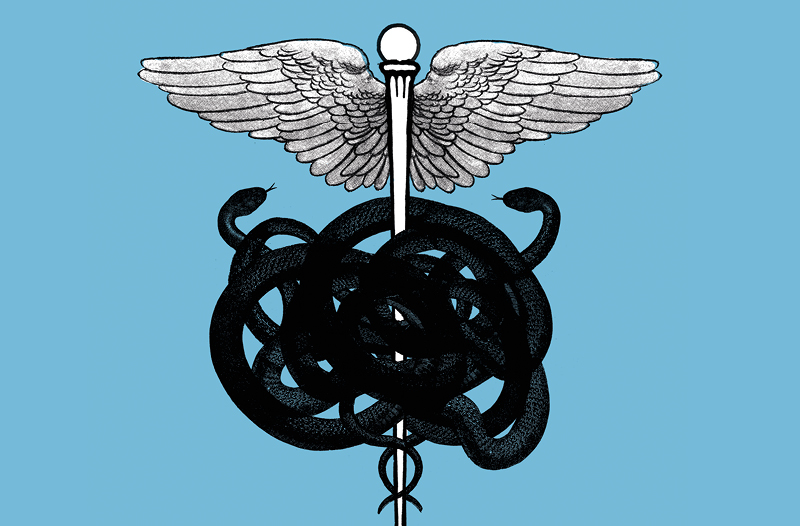
Pro Choice

Is the emergence of private health exchanges an outlier in the consumerization of employer-sponsored health insurance? Or simply the latest shiny toy in employee-sponsored benefits?
While not the first to establish what is more accurately described as a private marketplace, Aon Hewitt is attracting focus for its recent announcement that more than 100,000 employees from Sears and Darden Restaurants will use Aon Hewitt’s multi-carrier corporate healthcare exchange to select their 2013 health benefits. But while Aon Hewitt may be the largest private health exchange created to date, other large vendors, including Extend Health and Mercer, are close to establishing their own, and there are several smaller private exchanges already operating.
“I think that private exchanges are still in large part a lot of shine and glitter and the newest tool in the toolbox,” says Nancy Mellard, executive vice president and general counsel at CBIZ Benefits & Insurance Services. “None of us have figured out exactly what private exchanges are going to look like in the end. But they are something that all brokers and consultants who intend to be around and thriving in 2014 and beyond need to be asking: What do we need to do to look at our private exchange options for our appropriate customers?”
The Patient Protection and Affordable Care Act requires the creation of public exchanges starting in 2014 for individuals and small businesses—defined as 100 or fewer employees. Workers who do not meet certain income levels based on family size will receive federal subsidies to use in the public exchanges. Larger employers cannot send their employees to the public exchanges until 2017.
Private exchanges do not involve subsidies and therefore are more like marketplaces that have come to be called exchanges. Both public and private exchanges connect insurance companies with consumers wishing to purchase health insurance. The more participants there are in an exchange, the better participating carriers can spread risk and offer competitive prices.
In most cases, employers using a private exchange use a defined contribution strategy that gives each worker a set amount of credit to choose from among a menu of insurance options. Employees who opt for more expensive coverage would have to pay the difference, while employees who choose less expensive coverage would see the credit returned to their paychecks.
Proponents argue the model allows companies to fix their healthcare spending costs in advance. Opponents argue the model does nothing to improve the underlying cost of healthcare and, worse, could result in uninformed employees making bad decisions about their levels of coverage.
“It’s not a new idea,” says Bob Klonk, whose promotion to CEO of Oswald Companies takes effect Jan. 1. “The concept of defined contributions has been around since cafeteria plans were around. You’re tweaking it a little bit with the way you’re funding it, but the concept has been there before. It’s just come back to roost a little bit.
“I call it the shiny new toy. Everybody’s all excited about it because it’s a shiny new toy. Everybody’s going to crowd around, and they’re going to go to seminars and they’re going to look at it and come back and say, it’s just really a defined contribution model saying here’s how much money you have and go spend it.”
But while the idea may not be new, the Affordable Care Act has brought it to the limelight. Liazon’s Bright Choices Exchange wasn’t even called an exchange when it was created in 2007 for small to mid-sized companies in the Northeast. Liazon today supports more than 2,200 companies representing more than 50,000 employees. Its Bright Choice Exchange is growing at a rate of 100% a year and recently signed deals with Gallagher Benefits Services and Hub International.
“The Patient Protection Act has popularized the notion of exchanges,” says Alan Cohen, Liazon chief strategy officer and co-founder. “We were doing this for many years before the Patient Protection Act, but now that that is the law, people are looking at it and saying, ‘Tell me again about this exchange, I’ve heard about these before. This no longer sounds like some outlandish thing.’
“We definitely got to the point where companies are just fed up. They want to change the game, and changing the game is really about letting people make the choices instead of forcing the company to make the cost-control decisions. The fact that we get three to five calls a day from insurance brokers who want to learn about this tells me that this is the time. This is the next big thing.”
But giving employees more power to make choices carries its own risk, Klonk says, and doesn’t do anything to change the factors that contribute to rising healthcare costs.
“The upside is you are getting the employee involved in the purchase of their insurance,” he says. “That’s what consumerism is all about. The idea is to actually get the employees thinking about the types of coverage they are buying and how much it actually costs. There’s a lot of upside to it if they are properly educated to make the right decisions. But what you don’t want is to have a bunch of employees go in and pick the least expensive plan because they don’t want to spend any more and then they have a catastrophic claim and they can’t afford it because they didn’t realize that certain things weren’t covered.
“You can’t just draw a line in the sand and say, ‘OK, employees, I’m only going to pay X every year and that’s it, you pay the balance.’ If you don’t improve the health of that group and your claims keep going up, sooner or later those employees are just going to leave because they can’t afford to pay the balance and you end up with a pretty lousy workforce. You have to ask, is there still a mechanism in place to control the increasing cost of care? Are you still doing wellness programs? Are you still doing risk-reduction programs? Otherwise, it’s not sustainable.”
Single-Carrier vs. Multi-Carrier
Cohen says Bright Choices Exchange operates a single-carrier model. Aon Hewitt’s exchange features nine national and regional carriers. “With a single carrier, you can consolidate the risk,” Cohen says. “One of the challenges with broad-based choice is you get risk selection. Going with a single carrier eliminates the problem of adverse selection because all the risk is consolidated in a single carrier.
“The disadvantage is less choice. It’d be nice to offer more choice to the employees. So what we have done in a number of markets is have multiple, single-carrier exchanges so the employer can decide, ‘I want my employees to use this single-carrier exchange or maybe another single-carrier exchange.’”
Aon Hewitt’s Corporate Exchange offers benefits by nine national and regional carriers, including UnitedHealthcare, Cigna, and Health Care Service Corporation, which operates Blue Cross and Blue Shield plans for 14 million members, including 5 million national account members. Employees can choose from five levels of standardized medical plans, four levels of dental care and three levels of vision care. The benefits package for each of these levels is standardized across carriers, and there are only four moving pieces between the levels—deductible, coinsurance percentage, out-of-pocket maximum and pharmacy coverage. All other design provisions have been equalized to make it easier for employees to compare.
Ken Sperling, Aon Hewitt’s national health exchange strategy leader, says its exchange is an option for employers looking to reduce cost, transfer risk to insurers, encourage employees to make smarter healthcare choices and create a more sustainable healthcare benefit program.
Sperling says competition between insurers in the Aon Hewitt marketplace should result in more affordable coverage as insurance companies are forced to compete for business. And he says the exchange will make insurance costs more transparent for employees.
“Since 2006, large-employer costs for healthcare have gone up 40% while employee costs have gone up 82%,” Sperling says. “Our corporate exchange seeks to reverse this trend by incenting insurance companies to compete on price. In every consumer market where there is strong competition, prices go down as a result. The exchange creates a competitive and transparent environment for health insurance so employers can maintain their commitment to health benefits without further shifting costs to employees.”
Chris Brathwaite, spokesman for Sears Holdings, says the Aon Hewitt exchange represents a new way for Sears, which had been self-insured.
“We are taking a new approach to medical coverage, an approach that we think will better meet the needs of our diverse workforce, while also providing our company with increased efficiencies in our healthcare offerings due to the competitive marketplace created by the new model,” he says. “The corporate exchange creates a competitive market in healthcare benefits at the individual consumer level, and we’re optimistic that competitive forces will drive efficiency and have a positive impact on quality and costs.
“This is not about shifting costs. It’s about increasing associate choice and options for their healthcare, and leveraging a competitive market to continue to positively impact overall costs.”
Time for Homework
Mellard says brokers who want to succeed in the new world of exchanges need to be learning all they can right now.
“I would be less studying those that are up and running and more studying your client customer book,” she says. “I think we know the profile of a customer that would fit into a private exchange. It is an employer that is at his or her limit on struggling year after year with trying to hold the line on escalating healthcare costs. I think the customer profile is one who is willing to make a serious commitment to a focus on health and productivity—the whole wellness piece. I think it’s an employer that is willing to give up some control over their healthcare.
“Clearly the top three industries I see across the board that seem to be most interested in going to a private exchange right now are manufacturing, retail and healthcare. You look at your customer base and which ones fit with that profile. Then it’s sitting down and talking to them very seriously about their level of interest and then finding the right insurance carrier partners. I think those conversations are happening all around the United States with all of those brokers who will be surviving and thriving in 2014 and after.”
Klonk concurs.
“The brokers who become educated about the process and about the best programs out there will win because they are offering the best options and solutions to their employers,” Klonk says. “It’s understanding where this works, where it doesn’t work, the type of workforce that this is going to be appropriate for and educating your employers about where this is going to fit right. Then the broker will win. If the broker sells this as a catchall, it’s a mistake.”
Showtime
Many employers for years have used the exchange-based defined contribution model for health benefits for their pre-Medicare eligible retirees. What’s different this time is a heightened awareness of and focus on wellness and the effect lifestyle has on health and healthcare costs.
“It’s ‘Back to the Future’ in some ways, but I think we’re doing it differently because I think we have been doing a good job about educating the consumer, who is now more engaged in the purchase of healthcare and more engaged in their own personal health and well-being,” says Mellard. “I think it’s the ‘Perfect Storm’ right now.”




